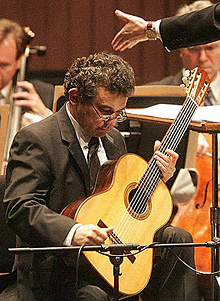 |
 |
 |
 Entertainment | April 2007 Entertainment | April 2007  
Discovering Classical Mexico
 Timothy Mangan - Orange County Register Timothy Mangan - Orange County Register


| | Guitarist Roberto Limón performs Manuel Ponce's "Concierto del Sur" for guitar and orchestra on Sunday. The melodic, French-flavored work was written in 1941 for Spanish guitarist Andrés Segovia. (Paul E. Rodriguez/OCR) |
The Pacific Symphony's 7th American Composers Festival, which opened Sunday afternoon at the Irvine Barclay Theatre, is this year devoted to the past and present of Mexican classical music. It's a huge and often distinguished repertoire and over the course of the event we'll hear music from the 17th, 19th, 20th and 21st centuries. This orchestra thinks big.

It will be impossible to cover the terrain in three programs; we'll familiarize ourselves with a few of the bigger names and currents. Sunday's program offered an Aztec dance, and music of two of the country's great composers from the last century and by two composers from this one. Dubbed "Discover Mexico," it lacked an overriding theme, and thus emerged as an interesting sampler without connected dots. Good enough.

It opened with a pair of Aztec dances, one stately, one rousing, performed in brilliant costume by the Ballet Folklórico of the Orange County High School of the Arts. Aztec music does not survive; some knowledge of the instruments that played it does, however. Here, a large conga-like drum was beat with thick wooden sticks, first marking time and then in a loud and athletic pattern. Someone ceremoniously blew a conch shell. The dancers shook rattles. No one vouched for the authenticity of the music or choreography and so we were left guessing. It was an entertaining way to start but it was minus the academic underpinning elsewhere evident in the festival (put together with the help of musicologist Joseph Horowitz).

Next came "Xochipilli," written in 1941 by Carlos Chávez (for another festival of Mexican music in New York) and subtitled "An Imagined Aztec Music for Four." Actually, there are 11 musicians: a piccolo, a flute, an E-flat clarinet, a trombone (which imitates the wail of a conch shell) and a battery of percussion played by seven musicians. It's a ritualistic, busily patterned piece of music that avoids sentimentality, melody and traditional tonality. It's bright, rhythmic and shrill and the Pacific Symphony musicians, led by guest conductor Enrique Diemecke (music director of the Long Beach Symphony) gave it a confident run-through.

Chávez and his colleague, the short-lived Silvestre Revueltas, are two of Mexican music's big names – they composed in modern, neo-classical styles, using folk music as inspiration. Manuel Ponce, a little their senior, wrote music in an eloquent Romantic manner, but changed with the times (he lived 1882-1948), incorporating elements of Modernism as he grew older.

His "Concierto del Sur," for guitar and orchestra, written in 1941 for Spanish guitarist Andrés Segovia, is a full-fledged concerto in three movements that sounds French, like Chabrier or perhaps Milhaud on a trip south of the border. The work is pleasingly melodic, dance-rhythmic and colorfully orchestrated and would seem to deserve to be heard a little more often. Unfortunately, guitarist Roberto Limón, Diemecke and the orchestra sounded as if they were reading it through for the second time; the performance was labored and lacked spark.

Two pieces by Ana Lara (b. 1959, on hand for the occasion) were also performed. Her "Canticum Sacrum," originally for a cappella voices and here orchestrated for strings, uses Gregorian chant as its linear basis and a technique called heterophony, in which those lines are played in slightly different versions by the musicians at the same time (here in slight rhythmic displacement from one another) creating soft blurs of melody and harmony that float in and out of focus. The work's solemn progression and religious feeling is reminiscent of Arvo Pärt or Henryk Górecki.

In fact, Lara composes in an international style, not instantly recognizable as Mexican. Her Serenata for Wind Quintet and String Quintet (2005) takes its start from Mozart's serenades but brings them into the 21st century. The woodwinds play multiphonics (an extended technique where more than a single note is created by one player); the strings hover, tremble and provide sound effects of their own. The work's six short movements have a lovely directness and simplicity, though; they were written for young musicians, the composer said. They're like little fragments of half-forgotten dreams.

Arturo Márquez's 1997 Danzon No. 3, for solo guitar (Limón) and chamber orchestra, closed the event in pops fashion. Before the performance of it, Diemecke demonstrated the salient characteristics of the danzon, a suave, hip-swiveling dance from Cuba that took its own Mexican form in Veracruz. Diemecke then proceeded to do the same in front of the orchestra during the performance of the piece, which is pretty much a straightforward and lush arrangement of the real deal. It was interesting to note that Márquez had at one time been an "experimental" composer.

The festival continues Friday with a historical survey of chamber music and then April 26-29, with orchestral programs led by Carl St.Clair.

Contact the writer: 714-796-6811 or tmangan@ocregister.com | 
 | |
 |



